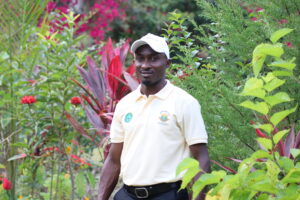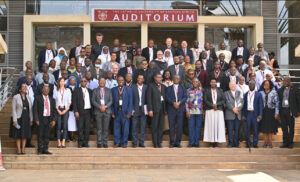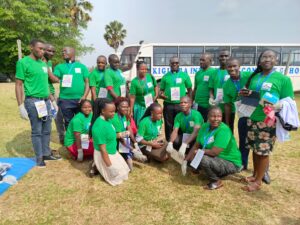PROJECT NAME: Smart Dustbin
INNOVATORS:
1. Byairungu Paul
2. Nakimbugwe Christine Whitney
3. Nakawuki Faith
4. Kwikiriza Noeline
5. Mugabi Priscilla
Mentor Ms. Immaculate Kisembo

PROJECT BACKGROUND
As part of the Laudato Si Club at Holy Cross Lake View Secondary School, we have developed a Smart Dustbin prototype to demonstrate how technology can be applied to solve environmental challenges. The prototype represents a functional model of what an actual smart dustbin would look like and how it can improve waste management in communities. This innovation supports the Club’s mission to promote environmental care, hygiene, and sustainability.
PROBLEM IDENTIFIED AND SOLUTION PROVIDED:
We observed that poor waste disposal is a major problem in our community, leading to pollution, bad odor, and the spread of diseases such as cholera and typhoid. As passionate stewards of the environment, we designed the smart dustbin to encourage proper waste disposal by minimizing physical contact with trash bins and improving hygiene. This project is a solution that supports clean, safe, and healthy surroundings while fostering environmental responsibility among the public.
MATERIALS USED IN BUILDING THE SMART DUSTBIN:
1. Microcontroller (Arduino Board):
• Acts as the brain of the dustbin.
• Manages communication between all components.
• Receives power and instructions via USB cable from a laptop.
2. Ultrasonic Sensor:
• Detects hand movements using ultrasonic waves.
• Sends signals to the microcontroller to initiate lid opening.
3. Servo Motor:
• Rotates between 0° and 270° to open and close the lid.
4. Battery (Minimum 9 Volts):
• Supplies power to the microcontroller and connected components.
5. Jumper Wires:
• Connect various electronic parts for signal transmission and power flow.
6. Boxes:
• Used for the dustbin’s outer casing and structural design.
7. Laptop (Programming Tool):
• Used for writing and uploading code using the C++ programming language.
8. Miscellaneous Items:
• Glue, seal tape, and spray paint for assembling and decorating the prototype.
HOW THE SMART DUSTBIN OPERATES:
After assembling all the components, the smart dustbin functions as follows:
• When a person brings their hand near the ultrasonic sensor, it detects the motion.
• The sensor sends a signal to the microcontroller, which processes the input.
• The servo motor receives a command and rotates the lid open to 270°.
• After about 1 second, the lid automatically closes by returning to 0°.
This contactless operation enhances hygiene by preventing direct touch with the bin lid.
PHASE TWO – FUTURE ENHANCEMENTS:
With additional funding and resources, we plan to upgrade the smart dustbin with a smart fill-level detection system:
• LED Indicators (Red & Green):
• Red light will indicate the bin is full.
• Green light will show the bin is still usable.
• Laser Sensor:
• Will monitor the amount of waste in the bin.
• Sends signals to change the LED color depending on the waste level.
This improvement will make the smart dustbin even more intelligent and efficient, helping users know when to empty it and promoting a cleaner environment.
CONCLUSION:
The Smart Dustbin Project by the Laudato Youth is a practical step toward solving real-world environmental problems using technology. It serves as both an educational tool and a prototype for larger-scale smart waste systems. Through this initiative, we aim to inspire others to think creatively, act sustainably, and protect our common home—Mother Earth.













